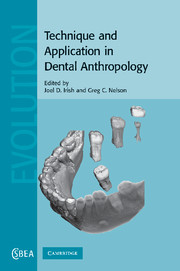Book contents
- Frontmatter
- Contents
- Contributors
- Acknowledgments
- Section I Context
- Section II Applications in assessing population health
- 4 Using perikymata to estimate the duration of growth disruptions in fossil hominin teeth: issues of methodology and interpretation
- 5 Micro spatial distributions of lead and zinc in human deciduous tooth enamel
- 6 The current state of dental decay
- 7 Dental caries prevalence by sex in prehistory: magnitude and meaning
- 8 Dental pathology prevalence and pervasiveness at Tepe Hissar: statistical utility for investigating inter-relationships between wealth, gender, and status
- Section III Applied life and population history
- Section IV Forefront of technique
- Index
- References
6 - The current state of dental decay
Published online by Cambridge University Press: 12 September 2009
- Frontmatter
- Contents
- Contributors
- Acknowledgments
- Section I Context
- Section II Applications in assessing population health
- 4 Using perikymata to estimate the duration of growth disruptions in fossil hominin teeth: issues of methodology and interpretation
- 5 Micro spatial distributions of lead and zinc in human deciduous tooth enamel
- 6 The current state of dental decay
- 7 Dental caries prevalence by sex in prehistory: magnitude and meaning
- 8 Dental pathology prevalence and pervasiveness at Tepe Hissar: statistical utility for investigating inter-relationships between wealth, gender, and status
- Section III Applied life and population history
- Section IV Forefront of technique
- Index
- References
Summary
Introduction
Dental caries is one of the most commonly recognized diseases in archaeological collections of human remains. Several decades of intensive clinical research have elucidated the mechanisms that underlie it, and its common pattern of occurrence in living people. After two centuries of high caries rates, it seems that the disease is now on the decline. It is less often appreciated that the high rates of the twentieth century were, in any case, an anomaly in archaeological terms. Not only were caries rates much lower throughout the great bulk of human existence, but the nature of the disease was different as well. The present chapter presents an overview of this pervasive and important dental disease – from cause and effect, to variation through time and among populations – and provides context for the remaining papers in this section.
The nature of dental caries
Dental caries is a progressive demineralization of dental enamel, cement, and dentin. It is the cumulative effect of changes in the pH environment of dental plaque deposits on the surface of the teeth. The pH varies during the day. It is lowered by the production of organic acids (especially lactic acid) through the fermentation of carbohydrates by the plaque bacteria, and raised again toward neutral pH by the clearance of fermentable carbohydrates from the mouth and through the buffering effect of saliva.
- Type
- Chapter
- Information
- Technique and Application in Dental Anthropology , pp. 111 - 135Publisher: Cambridge University PressPrint publication year: 2008
References
- 41
- Cited by



